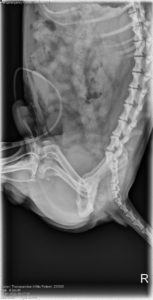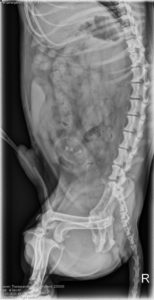Urinary Obstructions
Written by Hannah Alharayeri
Symptoms
Willie is an adorable 4-year old male dachshund. He presented to his regular veterinarian for vomiting. Upon examination, they noticed his abdomen was very tense and his bladder was large and firm. His veterinarian took radiographs of him to get a better idea of what was happening internally and to potentially confirm a urinary blockage.
After they took the x-rays, it was obvious that Willie was in fact obstructed. He not only had urinary stones in his bladder, but urinary stones lodged in his urethra, therefore not allowing him to urinate.
He was most likely vomiting from being in pain, as that is a common secondary response to pain. His veterinarian transferred him over to Atlantic Street Pet Emergency Center to alleviate the obstruction and surgically remove the stones.
Next Steps
Our first step when he arrived was to anesthetize him, so we could hopefully flush the stones that were lodged in his urethra, back up into his bladder. We did this so that he would only need one surgical incision rather than a urethrostomy and a cystotomy. Fortunately, the procedure was successful, and the stones were easily flushed back into the bladder. He was then taken into surgery for his cystotomy!
We removed three urinary stones from his bladder and submitted them to be analyzed along with a urinalysis and culture so we would know exactly what type of stones he had developed, and how to prevent them from occurring again. Willie will be starting a prescription urinary diet to help lower the chances of any crystals or stones from forming again.
Willie made an incredibly fast recovery from surgery and was able to return home to recover with his family the following day.
Dangers of Obstruction
Urinary Obstructions are unfortunately a common occurrence in both canines and felines. It is always very important to observe your animals when they go outside to eliminate to ensure that they are producing urine and not straining. This type of obstruction is life threatening. In worst case scenarios if not tended to on time, the animal’s bladder could rupture causing a uroabdomen, which then lends to complications and risks for the animal.
Willie’s case is a perfect example and success story, and shows that urinary issues can be treated, and managed to help your pet live a longer happier life.

An X-Ray Post-Op to ensure that all of the stones were removed, which they successfully were!

An X-ray that we took here after passing the urinary catheter and pushing the stones back up into his bladder. On this X-ray you can see the urinary catheter as well as the stones floating in his bladder prior to cystotomy. The reason for this film was to ensure that Willie did not have any other stones caught in his urethra so that we could move forward with his cystotomy surgery and remove the stones.